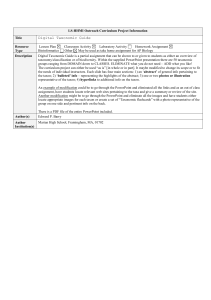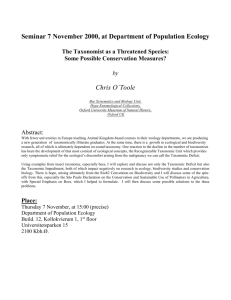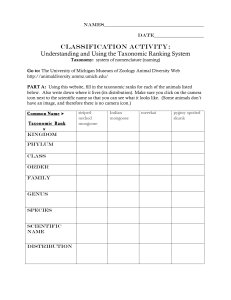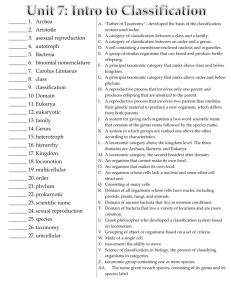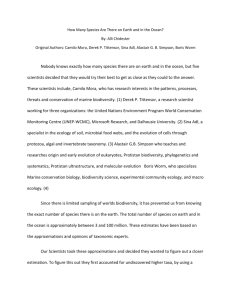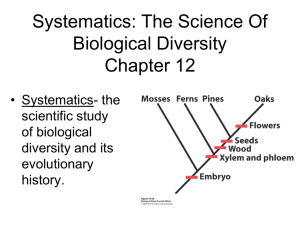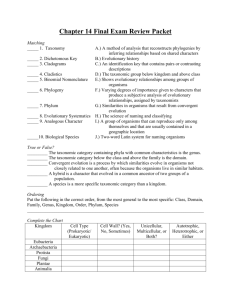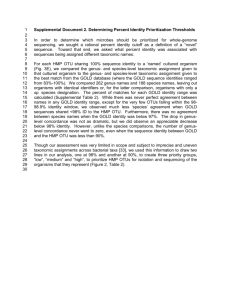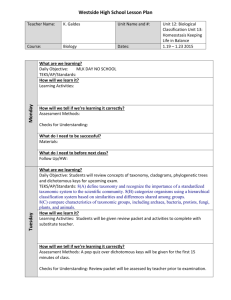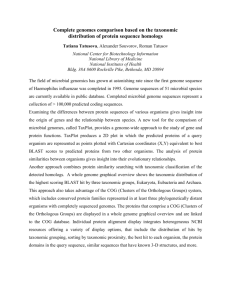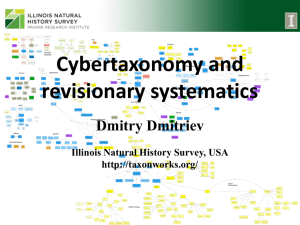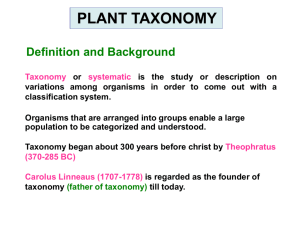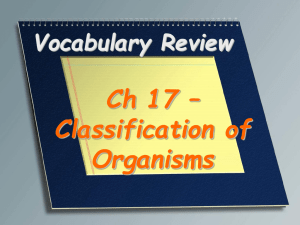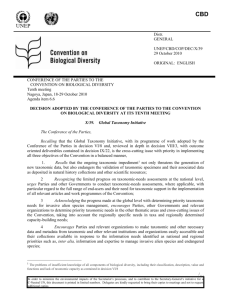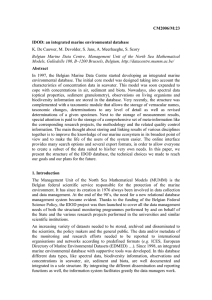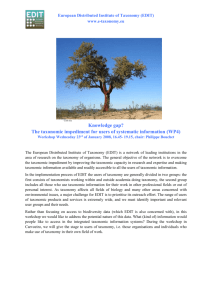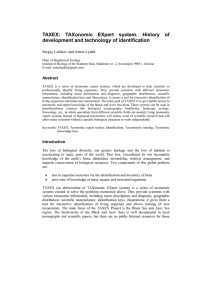Lesson Description
advertisement
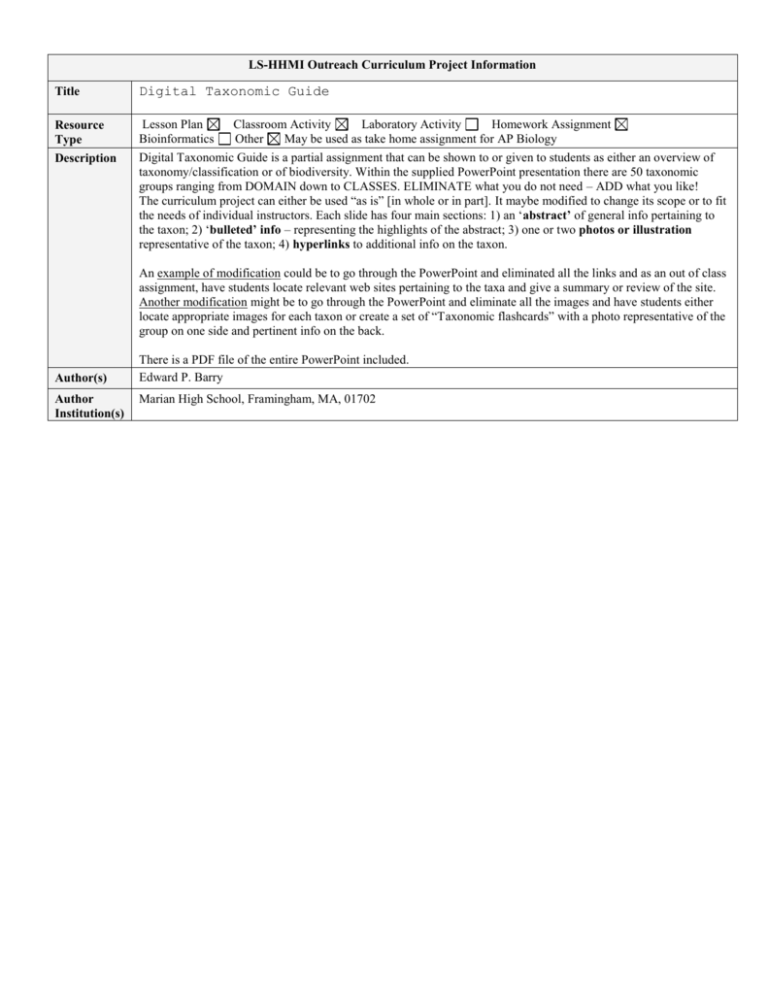
LS-HHMI Outreach Curriculum Project Information Title Digital Taxonomic Guide Resource Type Lesson Plan Bioinformatics Description Digital Taxonomic Guide is a partial assignment that can be shown to or given to students as either an overview of taxonomy/classification or of biodiversity. Within the supplied PowerPoint presentation there are 50 taxonomic groups ranging from DOMAIN down to CLASSES. ELIMINATE what you do not need – ADD what you like! The curriculum project can either be used “as is” [in whole or in part]. It maybe modified to change its scope or to fit the needs of individual instructors. Each slide has four main sections: 1) an ‘abstract’ of general info pertaining to the taxon; 2) ‘bulleted’ info – representing the highlights of the abstract; 3) one or two photos or illustration representative of the taxon; 4) hyperlinks to additional info on the taxon. Classroom Activity Laboratory Activity Homework Assignment Other May be used as take home assignment for AP Biology An example of modification could be to go through the PowerPoint and eliminated all the links and as an out of class assignment, have students locate relevant web sites pertaining to the taxa and give a summary or review of the site. Another modification might be to go through the PowerPoint and eliminate all the images and have students either locate appropriate images for each taxon or create a set of “Taxonomic flashcards” with a photo representative of the group on one side and pertinent info on the back. Author(s) Author Institution(s) There is a PDF file of the entire PowerPoint included. Edward P. Barry Marian High School, Framingham, MA, 01702 Objective To give students a survey of information/data associated with many major/less major taxonomic groups To allow students the opportunity to research further a group of organisms that may hold interest. Key Concepts Biodiversity Student Prep General intro to biodiversity and taxonomy; General internet/media researching techniques; vocabulary selection and review [possible] Materials Computer viewing ability [or pre-print PDF for hard-copy study Templates on CD Similarities/Differences among groups Taxonomy Classification Compare/contrast Internet access [for PPT links] Grade and Level(s) General College Prep Biology/ Honors Biology / In class, self-directed, or at-home study followed by in-class Q/A for AP Biology class Teacher Prep Time Varies depending on which sections of Varies depending on time allotted for research Class Time templates are eliminated by classroom instructor. 12CLS3.4 The millions of different species of plants, animals, and microorganisms that live on earth today are related by descent from common ancestors. National Standards 12CLS3.5 Biological classifications are based on how organisms are related. Organisms are classified into hierarchy of groups and subgroups based on similarities which reflect their evolutionary relationships Species is the most fundamental unit of classification. State Standards 5.2 - Describe species as reproductively distinct groups of organisms. Recognize that species are Sources See EdwardBarryMediaCopyrightInfo.docx within the Curriculum project documents; See Links embedded within PPT Links/additional info section of individual slides. Assessment Recommended assessment: Develop a series of “Who am I” questions as Test evaluation. An example of this type of question would be: “I am multicellular and eukaryotic. I am exothermic as well as terrestrial although I swim quite well. I have a nervous system as well as a closed circulatory system. I lay eggs, have a ‘beak’ but lack gills and feathers throughout my life …… Who am I?” further classified into a hierarchical taxonomic system (kingdom, phylum, class, order, family, genus, species) based on morphological, behavioral, and molecular similarities. The student would then either through memory or using a “Study Guide” developed by the instructor [which might include the Bulleted info from each group], figure out which Taxonomic group the question describes. The answer to the question would then be the “Taxonomic Outline” of the group. The answer for this question would be: Domain Kingdom Phylum/Division Class EUKARYA ANIMALIA CHORDATA REPTILIA The instructor could then get partial credit depending on much of the “outline” the students correctly identified. For example, if you were to give one point for the domain, kingdom, and phylum and two points for the class. So if a student got the domain, kingdom and phylum but incorrectly identified this organism as class aves – 3/5 point could be awarded.
